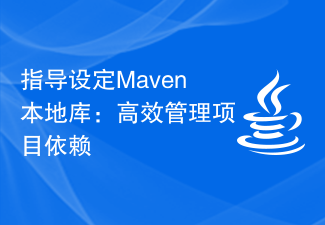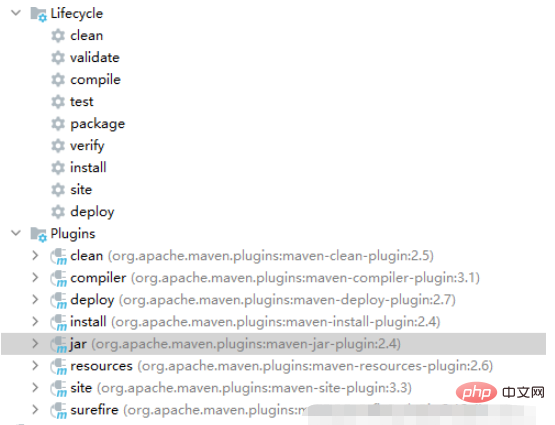 Java
Java javaTutorial
javaTutorial Guide: Maven local warehouse configuration tips to quickly deal with dependency management issues
Guide: Maven local warehouse configuration tips to quickly deal with dependency management issues
Maven Local Warehouse Configuration Guide: How to Easily Solve Dependency Management Issues
With the continuous development of software development technology, modern project development often relies on various third parties Libraries and frameworks. As one of the most popular build tools in Java project development, Maven plays a vital role in dependency management. By properly configuring the Maven local warehouse, you can effectively solve the dependency management problems in the project and improve the maintainability and reliability of the project. This article will introduce how to correctly configure the Maven local warehouse and demonstrate it through specific code examples.
1. Detailed explanation of Maven local warehouse
Maven local warehouse is the local storage location used by Maven to save project dependent libraries. All third-party jar packages downloaded through Maven will be saved in this directory. Down. By default, the Maven local repository is located in the ".m2" folder in the user's home directory. In this directory, there is a "repository" folder that stores the jar packages of all dependent libraries, and a "settings.xml" file that stores Maven's global configuration information.
2. Configure Maven local repository
2.1 Modify settings.xml
In the Maven installation directory, you can find "settings.xml" under the "conf" folder document. Open the file, search for the "localRepository" attribute in it, and specify the path to the local repository. For example:
<localRepository>/path/to/your/local/repository</localRepository>
Replace "/path/to/your/local/repository" with the location where you want to save the dependent library.
2.2 Command line modification
If you want to dynamically specify the location of the Maven local warehouse in the command line, you can use the following command:
mvn install -Dmaven.repo.local=/path/to/your/local/repository
3. Code example
To demonstrate how to configure a Maven local repository, we create a simple Java project that depends on the Apache Commons Lang library. First, make sure you have correctly configured the local repository path in Maven.
3.1 Create a Maven project
Create a Maven project through the following command:
mvn archetype:generate -DgroupId=com.example -DartifactId=my-project -DarchetypeArtifactId=maven-archetype-quickstart -DinteractiveMode=false
3.2 Add dependencies
In the project's pom.xml file, add Dependency on Apache Commons Lang:
<dependencies>
<dependency>
<groupId>org.apache.commons</groupId>
<artifactId>commons-lang3</artifactId>
<version>3.12.0</version>
</dependency>
</dependencies>3.3 Build the project
Execute the following command to compile the project and download the dependent jar package to the local warehouse:
mvn clean install
4. Verify the configuration
Open the location of the Maven local warehouse, and you will see that the jar package of Apache Commons Lang has been downloaded to this directory.
Through the above steps, you have successfully configured the Maven local warehouse and demonstrated how to use the dependency management function in the project. Properly configuring the local warehouse will help improve the efficiency and stability of project construction, making project development easier and more efficient.
In short, through the guide in this article, you can easily solve dependency management problems and better use Maven to build and manage your Java projects. I hope this article was helpful to you, and have a happy coding journey!
Conclusion
Maven local warehouse is an important part of project dependency management. Correct configuration can improve development efficiency and project maintainability. Through the introduction and examples in this article, I believe you have a clearer understanding and mastery. Continue to learn and explore, and better use Maven for project development!
The above is the detailed content of Guide: Maven local warehouse configuration tips to quickly deal with dependency management issues. For more information, please follow other related articles on the PHP Chinese website!
 指导设定Maven本地库:高效管理项目依赖Feb 19, 2024 am 11:47 AM
指导设定Maven本地库:高效管理项目依赖Feb 19, 2024 am 11:47 AMMaven本地仓库配置指南:轻松管理项目依赖随着软件开发的发展,项目的依赖包管理变得越来越重要。Maven作为一个优秀的构建工具和依赖管理工具,在项目开发过程中扮演着至关重要的角色。Maven默认会从中央仓库下载项目依赖,但有时候我们需要将一些特定的依赖包保存到本地仓库中,以便离线使用或避免网络不稳定的问题。本文将介绍如何配置Maven本地仓库,以便轻松管理
 Java之怎么实现maven打完jar包之后将jar包放到指定位置May 13, 2023 am 11:46 AM
Java之怎么实现maven打完jar包之后将jar包放到指定位置May 13, 2023 am 11:46 AM方式一通过maven-jar-plugin指定outputDirectory输出路径可以排除某些配置文件,没有文件夹的话会自动创建!org.apache.maven.pluginsmaven-jar-pluginD:\test**/*.properties**/*.xml**/*.ymlstatic/**templates/**方式二通过maven-resources-plugin指定outputDirectory输出路径org.apache.maven.pluginsmaven-resourc
 Java之Maven工程打包jar的方法是什么Apr 29, 2023 pm 06:31 PM
Java之Maven工程打包jar的方法是什么Apr 29, 2023 pm 06:31 PMMaven打包一般可以生成两种包一种是可以直接运行的包,一种是依赖包(只是编译包)。Maven默认打包时jar,如果需要修改其他类型。可以修改pom.xmljar/ear/ejbMaven工程默认引入的插件:1.一般的jar(不能运行)生成的jar只是一个编译包,并没有打包依赖jar包。通过控制台的编译日志可以看出来,方式使用maven-jar-plugin:2.4插件。java编译插件,可以设置jdk的版本等(如果不设置使用默认,可以不设置org.apache.maven.pluginsmav
 什么是Composer,它与PHP的关系是什么?May 12, 2023 pm 08:31 PM
什么是Composer,它与PHP的关系是什么?May 12, 2023 pm 08:31 PM随着现代Web开发技术的迅速发展,依赖管理成为了一个越来越重要的议题。无论是前端还是后端开发,我们需要引入各种各样的库和框架来达到更高的开发效率和更好的应用性能。而这些库和框架的组织、版本控制和安装管理问题则成为了一个值得思考和解决的难题。Composer就是为了解决PHP应用开发中依赖管理问题而推出的一个开源工具。它的作用类似于Node.js
 如何进行C++代码的依赖管理?Nov 04, 2023 pm 03:45 PM
如何进行C++代码的依赖管理?Nov 04, 2023 pm 03:45 PM如何进行C++代码的依赖管理?作为一种广泛使用的编程语言,C++常常用于开发涉及底层硬件、系统级别或具有高性能要求的应用程序。在实际开发中,C++项目往往会涉及到各种库、框架和其他依赖项,因此,进行代码的依赖管理变得尤为重要。本文将介绍几种常见的C++代码依赖管理方法,帮助开发者更好地管理项目中的依赖关系。一、手动复制依赖库最简单的依赖管理方法是手动将所需的
 Golang 框架中常见的依赖管理问题有哪些?Jun 05, 2024 pm 07:27 PM
Golang 框架中常见的依赖管理问题有哪些?Jun 05, 2024 pm 07:27 PMGo框架依赖管理中的常见问题和解决方案:依赖项冲突:使用依赖关系管理工具,指定接受版本范围,检查依赖项冲突。供应商锁定:通过代码复制、GoModulesV2文件锁定或定期清理供应商目录来解决。安全漏洞:使用安全审计工具,选择信誉良好的提供商,监控安全公告并及时更新依赖项。
 Maven 独孤九剑:Java 构建之无招胜有招Mar 08, 2024 pm 01:20 PM
Maven 独孤九剑:Java 构建之无招胜有招Mar 08, 2024 pm 01:20 PM1.Maven的无招胜有招Maven的核心思想在于遵循约定优于配置。它提供了一套默认规则,指导项目构建过程,而开发者只需根据特定需求进行少量定制。这种无招胜有招的策略赋予Maven极高的灵活性,使其适用于各种Java项目。2.项目结构约定Maven对项目结构有严格约定,包括目录组织和文件命名规则。项目根目录下一般包含以下子目录:src/main/java:存放源代码src/main/resources:存放资源文件src/test/java:存放测试代码src/test/resources:存放
 * Java 函数包管理和依赖关系:如何保持代码库的整洁和可维护性Apr 24, 2024 pm 02:33 PM
* Java 函数包管理和依赖关系:如何保持代码库的整洁和可维护性Apr 24, 2024 pm 02:33 PM问题:如何管理Java函数包和依赖关系?答案:使用函数包管理器(如Maven或Gradle)来声明依赖关系。在pom.xml或build.gradle文件中指定依赖项的坐标和范围。使用Maven或Gradle命令构建项目,以解析和管理依赖关系。


Hot AI Tools

Undresser.AI Undress
AI-powered app for creating realistic nude photos

AI Clothes Remover
Online AI tool for removing clothes from photos.

Undress AI Tool
Undress images for free

Clothoff.io
AI clothes remover

AI Hentai Generator
Generate AI Hentai for free.

Hot Article

Hot Tools

Zend Studio 13.0.1
Powerful PHP integrated development environment

Notepad++7.3.1
Easy-to-use and free code editor

Atom editor mac version download
The most popular open source editor

SAP NetWeaver Server Adapter for Eclipse
Integrate Eclipse with SAP NetWeaver application server.

MinGW - Minimalist GNU for Windows
This project is in the process of being migrated to osdn.net/projects/mingw, you can continue to follow us there. MinGW: A native Windows port of the GNU Compiler Collection (GCC), freely distributable import libraries and header files for building native Windows applications; includes extensions to the MSVC runtime to support C99 functionality. All MinGW software can run on 64-bit Windows platforms.






